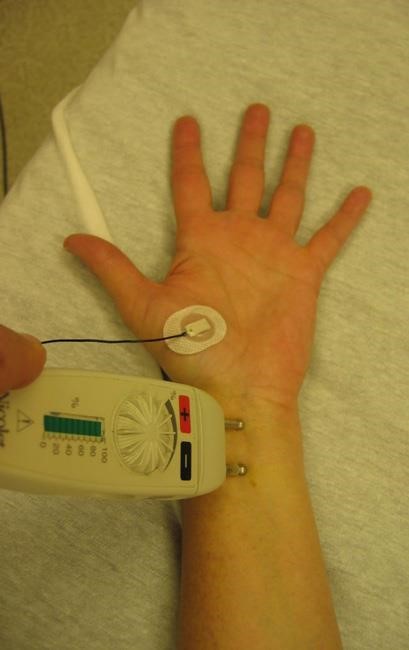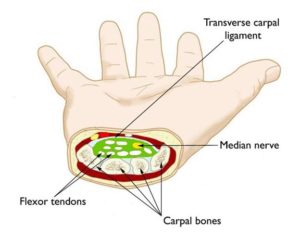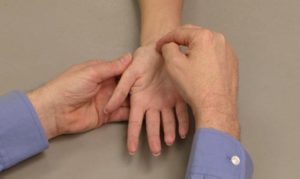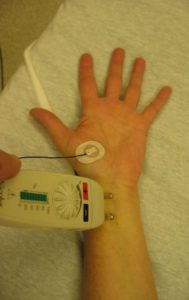
Hello, I am Dr. Ayisha Livingstone, MD, a Fellowship trained and Board-Certified Orthopedic Hand Surgeon. I reside and practice in Fort Lauderdale, Florida with the South Florida Orthopedic Group. I completed my Orthopedic Residency at the University of Miami, and my Fellowship at the University of Pittsburgh.
I genuinely love my community here in South Florida and decided to help bring awareness on some common hand and wrist ailments that present to my practice. Once a month I will post a new topic on the website. Please feel free to use the contact information to see me or my colleagues with any questions or concerns.
Carpal tunnel syndrome
What is it…?
Carpal tunnel syndrome is caused by pressure on the median nerve. The carpal tunnel is a narrow passageway surrounded by bones and ligaments on the palm side of the hand. When the median nerve is compressed, symptoms can include numbness, tingling, and weakness in the hand and arm. In most patients, carpal tunnel syndrome gets worse over time. If untreated for too long, it can lead to permanent dysfunction of the hand, including loss of sensation in the fingers and weakness. For this reason, it is important to diagnose and treat carpal tunnel syndrome promptly. Early symptoms can often be relieved with simple measures like:
- Wearing a wrist splint while sleeping
- Exercises to keep the nerve mobile
- Avoiding certain activities that aggravate your symptoms
- A steroid injection into the carpal tunnel
If pressure on the median nerve continues, however, it can lead to nerve damage and worsening symptoms. To prevent permanent damage, surgery to take pressure off the median nerve may be recommended for some patients.
Symptoms may include:
- Numbness, tingling, burning, and pain — primarily in the thumb and index, middle, and ring fingers. This often wakes people up at night.
- Occasional shock-like sensations that radiate to the thumb and index, middle, and ring fingers
- Pain or tingling that may travel up the forearm toward the shoulder
- Weakness and clumsiness in the hand — this may make it difficult to perform fine movements such as buttoning your clothes
- Dropping things — due to weakness, numbness, or a loss of proprioception (awareness of where your hand is in space)
- Nighttime symptoms are quite common. Because many people sleep with their wrists bent, symptoms may awaken you from sleep. During the day, symptoms often occur when holding something for a prolonged period with the wrist bent forward or backward, such as when using a phone, driving, or reading a book.
- Many patients find that moving or shaking their hands helps relieve their symptoms.
What causes it…?
Most cases of carpal tunnel syndrome are caused by a combination of factors. Studies show that women and older people are more likely to develop the condition.
Other risk factors for carpal tunnel syndrome include:
- This is a key factor. The carpal tunnel may be naturally smaller in some people, or there may be anatomic differences that change the amount of space for the nerve — and these traits can run in families.
- Repetitive hand use. Repeating the same hand and wrist motions or activities over a prolonged period may aggravate the tendons in the wrist, causing swelling that puts pressure on the nerve.
- Hand and wrist position. Doing activities that involve extreme flexion or extension of the hand and wrist for a prolonged period can increase pressure on the nerve.
- Hormonal changes during pregnancy can cause swelling that results in pressure on the nerve.
- Health conditions. Diabetes, rheumatoid arthritis, and thyroid gland imbalance are conditions that are associated with carpal tunnel syndrome.
Anatomy…
The carpal tunnel is a narrow passageway in the wrist, about an inch wide. The floor and sides of the tunnel are formed by small wrist bones called carpal bones.
The roof of the tunnel is a strong band of connective tissue called the transverse carpal ligament. Because these boundaries are very rigid, the carpal tunnel has little capacity to stretch or increase in size.
The median nerve is one of the main nerves in the hand. It originates as a group of nerve roots in the neck; these roots then come together to form a single nerve in the arm.
The median nerve travels down the upper arm, across the elbow, and into the forearm, then passes through the carpal tunnel at the wrist on its way to the hand and fingers. It separates into several smaller nerves along the way, particularly once it reaches the palm. These nerves allow for feeling in the thumb, index finger, middle finger, and half of the ring finger (the thumb side).
The median nerve also controls the muscles around the base of the thumb.
The nine tendons that bend the fingers and thumb also travel through the carpal tunnel with the nerve. These tendons are called flexor tendons because they flex the fingers and thumb.

My Examination:
During your evaluation, I will talk to you about your general health and medical history and will ask about your symptoms.
I will carefully examine your hand and wrist and perform a number of physical tests. During these tests, I may:
- Press down or tap along the median nerve on the palm side of your wrist and hand to see if it causes any tingling into your fingers (Tinel’s sign).
- Bend and hold your wrists in a flexed position to test for numbness or tingling in your hands.
- Test sensitivity in your fingertips and hands by lightly touching them with a special instrument while your eyes are closed.
- Check for weakness in the muscles around the base of your thumb.
- Look for atrophy (wasting) in the muscles around the base of your thumb. In severe cases, these muscles may become visibly smaller.

Tests…
Electrophysiological tests: I may order electrophysiological testing of your nerves to measure how well your median nerve is working and help determine whether there is too much pressure on the nerve.
These tests will also help me to determine:
- The severity of your carpal tunnel syndrome
- Whether the nerve is compressed in other locations
- Whether other nerves are affected
- Whether you have a medical condition (e.g., neuropathy) affecting your nerves in addition to carpal tunnel syndrome

Close up of an EMG being performed with a nerve conduction study.
Electrophysiological tests may include:
- Nerve conduction studies (NCS). These tests measure the signals travelling in the nerves of your hand and arm and can detect when a nerve is not conducting its signal effectively. Nerve conduction studies can help your doctor determine how severe your problem is and help to guide treatment.
- Electromyogram (EMG). An EMG measures the electrical activity in muscles. EMG results can show whether you have any nerve or muscle damage.
Treatment
Although it is a gradual process, for most people carpal tunnel syndrome will worsen over time without some form of treatment. For this reason, it is important to be evaluated and diagnosed by your doctor early on. In the initial stages, it may be possible to slow or stop the progression of the disease.
Look out for my blog in July 2022 where I will discuss the treatment options, both surgical and non-surgical, for carpal tunnel syndrome.
See you next month!!!
If you feel as if you or any of your family and friends could have any of the symptoms provided here, I am ready and happy to help you keep your hands healthy and functional.
Thank you,
Ayisha Livingstone, MD,Fellowship Trained and Board-Certified Orthopedic Hand Surgeon

